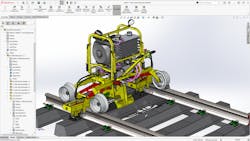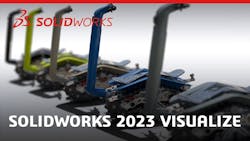SolidWorks 2023 Delivers Across-the-Platform Upgrades
What you’ll learn:
- SolidWorks capabilities and applications.
- What are this year’s improved features?
Another 3DExperience World has come and gone, and Dassault Systèmes didn’t waste any time showcasing the company’s latest revision of SolidWorks 2023. The platform has been updated with new features and improvements to what’s arguably considered one of the top 3D CAD packages.
Enhanced collaboration, design automation, and the latest simulation capabilities are just a few of the features designed to help engineers innovate their designs across the entire product lifecycle, from inception to marketing. As with past SolidWorks revisions, there are also performance updates for CAD modeling, Simulation, Composer, Visualize, MBD, PDM, and more.
SolidWorks has been a premier CAD platform for over 25 years, providing engineers with the tools to design, simulate, manufacture, manage data, and collaborate all under one roof. In this article, we’ll take a look at some of the latest features and updates incorporated into the latest edition of SolidWorks, as well as access to the cloud services of the 3DExperience platform, which is included with every license.
What’s New in SolidWorks 2023
SolidWorks Simulation is an invaluable platform that allows engineers to perform virtual testing and analysis of their designs before heading to the manufacturer. It features a comprehensive toolset for validating the performance of those designs using stress analysis, fatigue analysis, thermal analysis, vibration, and more.
In essence, engineers can subject their designs to real-world conditions under any number of environments to detect flaws and make decisions to correct them before moving on to the next step in the product lifecycle.
SolidWorks 2023 boasts some newly added features to Simulation to help streamline the design process, including a new algorithm for unconstrained bodies (Fig. 1). The new algorithm differs in that it uses singular value decomposition (SVD) to correct a reduced stiffness matrix over the previous lower upper (LU) decomposition in Simulation 2022. The algorithm helps to prevent errors before running simulations to provide the user with faster results.
Under the hood, the algorithm computes and displays all free rigid modes of unstable components, which is visualized with the components undergoing rigid body motion. Engineers can use the information to apply the correct boundary conditions or define proper contact positions.
Simulation also packs a new Contact Penalty Stiffness Scale Factor feature designed to produce simulation results faster than ever before. This new feature controls the contact penalty stiffness at the global level, meaning users can specify the penalty stiffness from 0.01 to 1, allowing them to relax or tighten the rate of conversion. A lower stiffness factor will generate quicker results with an increased approximation, while a higher factor will produce a slower convergence but give more accurate results.
In addition, SolidWorks incorporates function-based processing in Simulation 2023, replacing file-based processing to transfer stiffness data to the solver. This means that function-based processing is extended to frequency and buckling studies and linear static studies that provide node-to-surface interactions and virtual wall definitions. Engineers also will find updated versions of Thermal Analysis, Frequency Analysis, Linear/Nonlinear Analysis, and Dynamic and Linearized Buckling Analysis features (Fig. 2).
SolidWorks Assemblies Gets a Facelift
SolidWorks Assemblies has been upgraded with new capabilities and enhancements, including the ability to open large assemblies and instances to skip for most pattern types. What’s more, users can select options to specify which configurations are affected by those skipped instances, providing increased efficiency and speed through the design flow process. And the integrated Replace Component command now allows users to replace a single component, multiple components of the same type, or all in every level of a completed assembly.
Furthermore, users can optimize the resolve mode automatically by selectively using lightweight technology when loading components in resolved mode. They also can speed up downstream processes by exporting those assembly components as separate Step files.
Assembly Workflows have been streamlined, too, requiring fewer steps to complete. This can be done by ensuring design integrity by automatically replacing lost mate references with alternative mate references, including faces, edges, planes, axes, and points. Users are able to save additional time when designing assemblies by using the ability to suppress unneeded Magnetic Mates and Connection Points.
BOM Part Numbers have been enhanced as well, including a new Document property available for the Default part number to be used in a bill of materials (BOM) for a new configuration. Users can then save the setting in their template, ensuring that the correct standard part number is used every time. In addition, part geometry can be created more quickly with multi-body modeling improvements and extensive use of coordinate systems. Users can reference coordinate systems in 3D sketches, 2D sketch dimensions, and mirroring to speed part modeling.
An Even Clearer View with Visualize
SolidWorks Visualize is an exciting platform that allows engineers to create photo-quality images, animations, and more using 3D CAD models (Fig. 3). Component, Part, and Body import mode now mimics the SolidWorks Tree flow, providing a more streamlined workflow between the design and rendering phases.
Preview quality also has been improved for PBR materials, giving a more realistic view of a model’s rendered state. It incorporates the Steller Render Engine for increased performance and compatibility with other CAD software.
Streamlining of the Visualize Color Picker brings improvements to key areas, making it possible to source colors from almost anywhere. A new hue slider allows users to fine-tune their palates, even in RGB and CYMK modes. Swatches can be made, populated, locked and shared, as well as be incorporated into existing swatches using different file types like HTML, SVG, and ACB.
SolidWorks 2023 is another major update of the popular all-in-one CAD package designed to help engineers through the entire product lifecycle. It brings sizable developments in connectivity and feature enhancements by including 3DExperience in the cloud, streamlined workflows via MBD (Model-based Definition), 3D Sculptor, and Creator. The inclusion of Cloud Data Management allows engineers to store and manage all of their data with greater ease and efficiency.
Discussed here are just a few of the new features and enhancements that can be found in SolidWorks 2023. More information can be found on the SolidWorks website.
About the Author
Cabe Atwell
Technology Editor, Electronic Design
Cabe is a Technology Editor for Electronic Design.
Engineer, Machinist, Maker, Writer. A graduate Electrical Engineer actively plying his expertise in the industry and at his company, Gunhead. When not designing/building, he creates a steady torrent of projects and content in the media world. Many of his projects and articles are online at element14 & SolidSmack, industry-focused work at EETimes & EDN, and offbeat articles at Make Magazine. Currently, you can find him hosting webinars and contributing to Electronic Design and Machine Design.
Cabe is an electrical engineer, design consultant and author with 25 years’ experience. His most recent book is “Essential 555 IC: Design, Configure, and Create Clever Circuits”
Cabe writes the Engineering on Friday blog on Electronic Design.




